The world’s tropical forests are often referred to as the ‘lungs of the planet’, taking up carbon dioxide and releasing oxygen. However, these vast, green,
breathing spaces may be running out of puff.
It has long been known that tropical forests were helping to keep a check on the rising global temperatures by storing carbon dioxide as biomass in their
roots, stems and leaves. However, it seems that deforestation is finally catching up with our human actions. Forests are often cleared to make way
for new farms, roads and villages but scientists have discovered something much more interesting, and perhaps, alarming.
An article in Science, 13th October, presented by Baccinin et al., reports how they used MODIS pantropical satellite data from 2003 to 2014 to look at how the carbon density of live, above-ground woody vegetation changed from year to year. What they found was that, far from being a carbon sink, or a vast carbon storage system, tropical forests were actually a net carbon source.
As well as deforestation, which is perhaps the most widely recognised and well-known cause of tree loss across the planet, other factors are much bigger
contributors to carbon emissions. These include forest degradation through environmental change, natural causes such as pests and diseases, wildfires
(as recently seen in California and Portugal) and human actions such as selective thinning. Selective thinning is a process which removes chosen trees
from a forest without clear felling large areas. From above, the forest still appears intact, but from the ground it is easy to see that the forest
is less dense. As a result it is unable to absorb as much carbon as before.
By comparing 500m2 parcels of imagery from the satellite data the researchers could determine the amount of carbon emitted and the amount absorbed over
that time. Results showed that the forests were not absorbing as much carbon and were actually emitting more carbon annually. In fact the carbon losses
due to deforestation and forest degradation were double the carbon gains from tree growth in the forests. Surprisingly, more than two thirds of the
carbon losses were from forest degradation, not deforestation.
These findings show how important it is to consider forest degradation in climate change calculations and that we shouldn’t be complacent just because
we can see canopy cover across the world’s forests. Nancy Harris, research manager of the forest program at the World Resources Institute, Washington
D.C. said, “We’ve known for a long time that forest degradation is happening, but haven’t had a good way to measure it. This paper goes a long way
to capturing it in an empirical way.”
You can read an abstract from the paper here.











